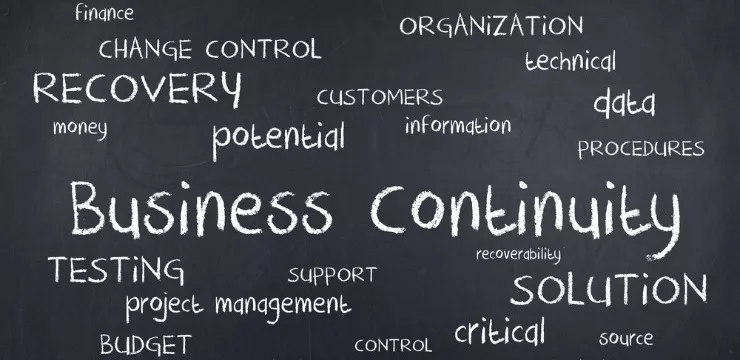
What is business continuity and why is it important for your business?
It is absolutely essential for businesses to maintain continuous operations in the face of disaster or disruption, which is the core focus of business continuity.
In today’s uncertain and changing world, natural disasters, digital disruption, and many other factors can interfere with an organization’s normal operations. For that reasons, it is critical to understand the fundamentals of business continuity and to develop plans designed to maintain normal business operations in the face of adversity.
Below, we’ll explore these concepts in more detail, starting with a basic definition of the concept.
What Is Business Continuity?
Business continuity and business continuity planning are aimed at minimizing the negative impacts of disruptive forces, such as natural disasters. As many organizations discovered during the COVID-19 outbreak, business continuity planning can offer a vital safety net to minimize the negative impacts of crises that extend beyond natural disasters.
Generally speaking, business continuity involves:
- Planning for potential threats that could disrupt a business
- Defining key operations and tasks needed to maintain normal business functions
- Outlining processes and procedures to follow during different circumstances
- Building systems and processes that minimize IT disruptions
- Creating recovery plans in the event of data loss
When disasters and crises do occur, an organization’s ability to manage those disruptions can mean the difference between success and failure.
In today’s continually changing business world, it is more important than ever to create a business continuity plan.
The Importance of Business Continuity in a Changing World
Many factors can disrupt an organization’s day-to-day operations, such as:
- Cyber attacks
- Natural disasters
- Digital disruption
- International conflicts
- Widespread illness
Successfully mitigating risks such as these can…
- Help organizations operate normally, even during emergencies or disasters
- Reduce the negative impacts of disasters and crises
- Maintain positive customer experiences
- Keep employees engaged and productive
- Stay more resilient and flexible during difficult times
Different types of threats can impact an organization differently, and each one should be separately assessed and planned for. Natural disasters that disrupt a supply chain, for instance, will have a different impact than, for instance, data breaches.
Regardless of the specific tactics, however, business continuity plans should remain focused on the same fundamental principles, which we’ll look at next.
Key Pillars of Business Continuity
Business continuity efforts should be designed to protect and maintain the organization’s most essential products and services, as well as the business functions that support them.
To ensure that an organization remains profitable, it is important to create plans that maintain:
- The customer experience. Disruptions to products, services, and the customer experience can all have rapid and negative impacts on an organization. Ensuring the uninterrupted delivery of products and services – as well as a consistent and positive customer experience – should be the top priority for any business continuity plan.
- IT infrastructure and assets. Without digital technology, the modern organization would cease to function, which is why businesses must do all they can to protect and maintain their IT assets. This requires disaster prevention and recovery solutions, which can be provided by managed IT providers, for instance.
- Employee capabilities and the employee experience. If emergencies or other disruptive changes interfere with employees’ ability to do their job, then the rest of the business will suffer accordingly. For that reason, it is important to make sure that employees have the right tools and skills to do their jobs, even under extenuating circumstances. Digital training, as explained below, enabled many employees to work from home effectively during the COVID-19 pandemic. This, in turn, helped organizations maintain continuous operations, despite the difficult circumstances.
As mentioned above, most business continuity planning begins by identifying risks and threats, then devising protocols, procedures, and processes that minimizes those risks.
In 2020, businesses around the globe experienced massive disruptions due to the outbreak of the novel coronavirus, interfering with a wide range of businesses and forcing many employees to work from home. Organizations that had effective remote working and training programs were able to adapt more effectively, while those that didn’t had to quickly adopt new tools and processes.
This is just one example of the advantages of creating a business continuity plan, however.
Every business is unique and will face a unique set of challenges and potential risk factors, which can vary widely from organization to organization. Agricultural businesses, for instance, can face risks posed by natural disasters, weather, or supply chain disruptions. Financial businesses, on the other hand, will face different types of challenges, which can range from cybersecurity threats to economic downturns.
Regardless of the circumstances, however, by prioritizing the three business areas mentioned above, modern organizations will ensure that their workforce can continue to deliver great products, services, and customer experiences – which are the fuel that every business relies upon to stay successful.
WalkMe Team
WalkMe spearheaded the Digital Adoption Platform (DAP) for associations to use the maximum capacity of their advanced resources. Utilizing man-made consciousness, AI, and context-oriented direction, WalkMe adds a powerful UI layer to raise the computerized proficiency, everything being equal.



